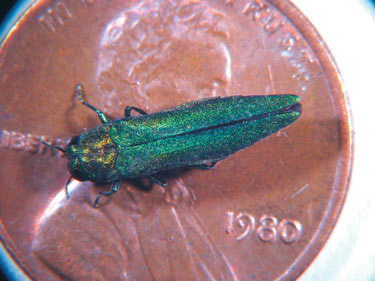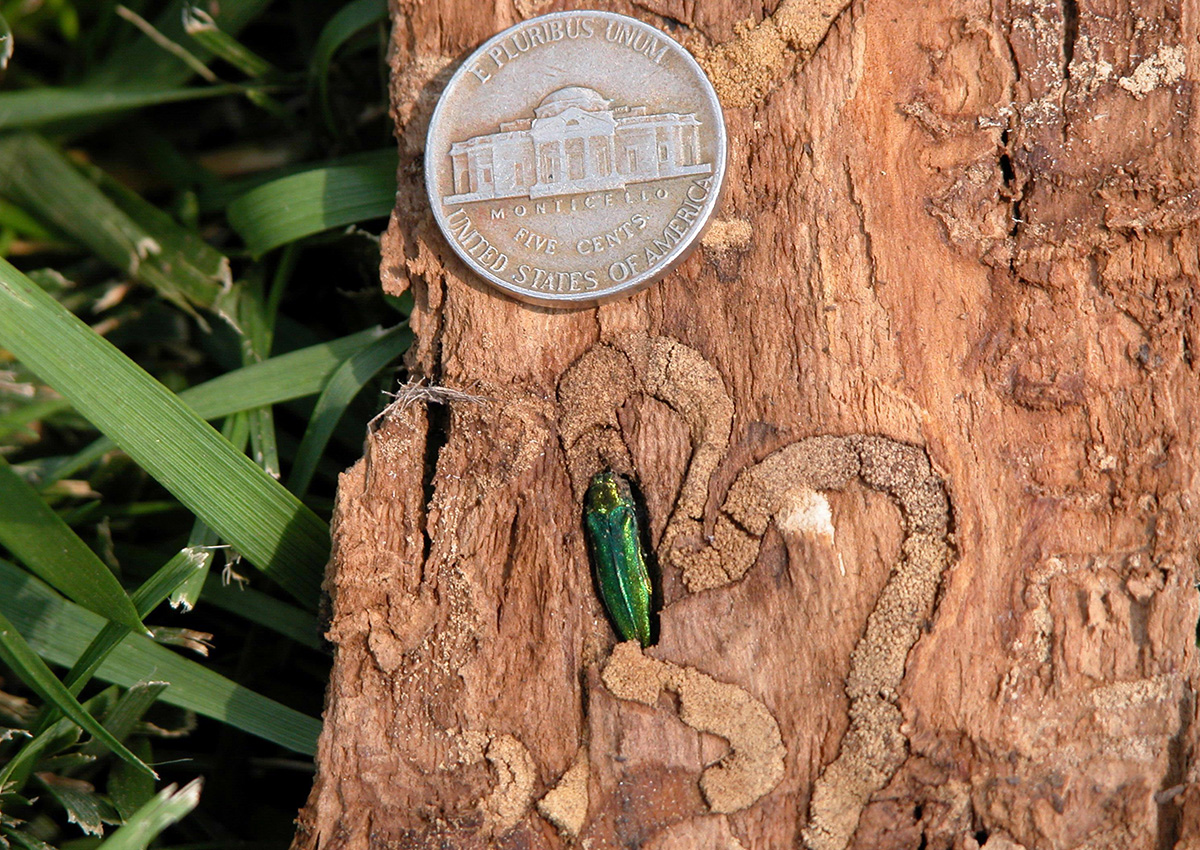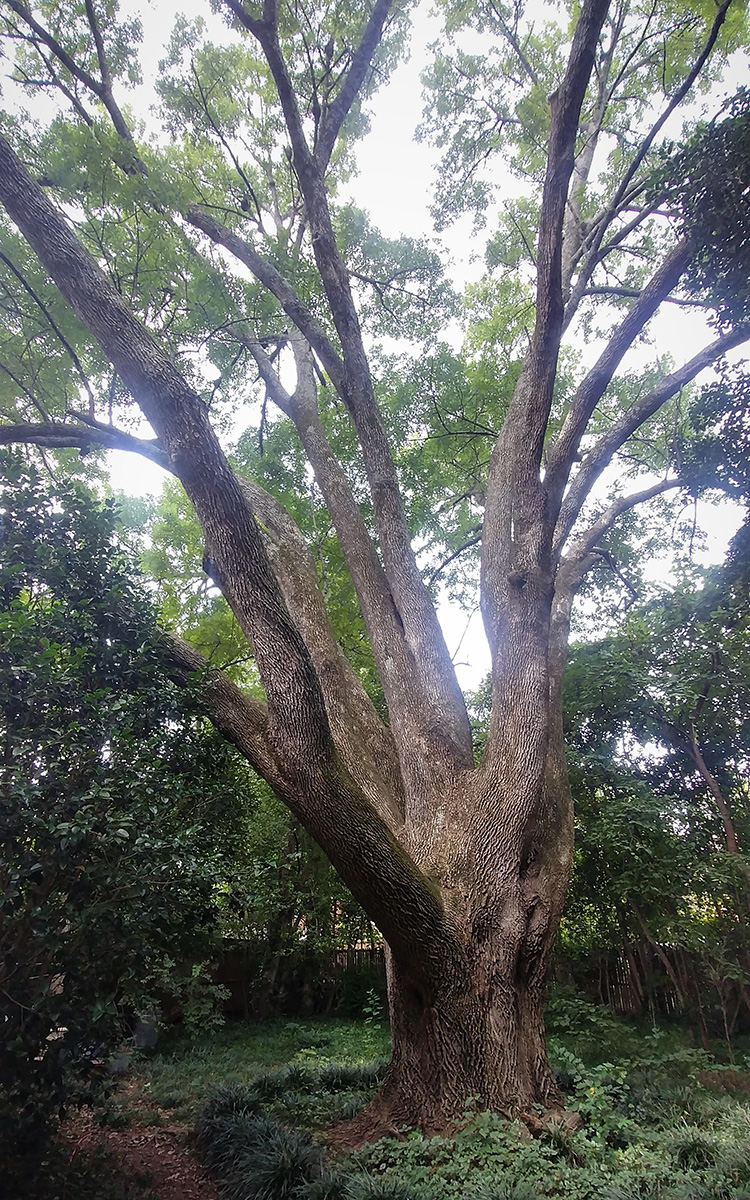
Emerald ash borer (Agrilus planipennis) has gained a certain notoriety over the last 20 years. This pest has been responsible for the death of over 100 million ash trees (Fraxinus spp. and cvs., Zones 3–9) and counting in North American landscapes and forests. Native to Asia, this insect was first detected in the Detroit area in 2002, although there is speculation that it had been established many years prior to detection and identification. The theory is that it entered the country in wooden packing materials from China. Emerald ash borer has now been detected in thirty-five U.S. states, the District of Columbia, and five Canadian provinces. While it is widespread in the eastern United States and is present on the edge of the West Coast, emerald ash borer is by far most heavily concentrated in the Midwest and Mid-Atlantic states. In my small town of Janesville, Wisconsin, there are dead ash trees everywhere.

Understand the life cycle
This bright, metallic-green adult beetle is about 1/2 inch long and 1/8 inch wide. The damage to ash trees actually comes from beetles in the larval stage. Female beetles lay eggs between bark layers and crevices of the ash tree. The larvae hatch within a week or so, bore into the tree, and feed on the inner bark. They create S-shaped galleries that disrupt both the xylem and phloem of the tree and lead quickly to conspicuous symptoms of decline as the tree’s ability to transport water and nutrients is severely compromised. Adults later emerge from the tree in late May and early June and create D-shaped exit holes.
Look for this damage to identify an infestation
Some symptoms to look for that would indicate the presence of emerald ash borer include the thinning and dying of tree crowns and canopies, suckers (epicormic sprouts) at the base of the tree, splitting bark (typically vertical), tunneling under the bark, D-shaped exit holes, and significant woodpecker activity. Smaller ash trees can die within just one to two years of being infested by emerald ash borer, while large trees might make it three to four years.

Scientists are on the case
There has been significant progress in evaluating the effectiveness of both biological and chemical controls for emerald ash borer. Research is showing that the larvae of four parasitoid wasp species are known to kill this pest. These wasps lay eggs on the beetle larvae, which then, in turn, hatch to become wasp larvae that consume and kill the beetle larvae. Over 8 million parasitoid wasps have been released to date, and in many of these studies their effectiveness had been significant. However, it is not likely that this approach on its own will combat the momentum and scale of the emerald ash borer problem.
For this pest, you may need to bring out the big guns
Systemic insecticides have become a popular mechanism for combatting emerald ash borer in ash trees that have been lightly infected or are in an area that is prone to infection due to the proximity of other infected trees. Unfortunately, for emerald ash borer infestations, there is nothing to be done for a tree that is already infested apart from using systemic insecticides. Effective control requires the chosen product to be applied at the correct time with the proper method. It is important to mention that the trees being treated need to be healthy enough to carry the insecticide throughout the tree. A certified arborist should be able to give you advice on a proper course of action for treating your trees, as there are also different options for the method of application, which is typically required to be reapplied every two to three years.
Don’t move firewood
If you decide to cut down an infested tree, it is important not to move the wood from the vicinity of the removal site, particularly as firewood. This is what has contributed to the quick spread of emerald ash borer in the past. Consider immediate chipping of the wood and burying the material or burning it that season. But there are ways to use the wood in which the outer layers of the tree (the parts infested by emerald ash borers) is destroyed and the remainder utilized as lumber.

Be proactive
Consider evaluating your ash trees if you haven’t already. Recent economic studies have concluded that effective treatment of ash trees is much less costly than their removal. Additionally, maintain good cultural practices such as pruning, fertilization, mulching, and proper irrigation in order to keep your trees healthy and unstressed, thus improving their chances of resisting an emerald ash borer infection.
With so many ash trees in our forests and landscapes, the battle against emerald ash borer will continue in earnest. The USDA APHIS site has some of the most current, up-to-date information on emerald ash borer, and the USDA Emerald Ash Borer Hotline (1-866-322-4512) offers excellent support for any additional questions you may have.
—Mark Dwyer, former director of horticulture at Rotary Botanical Gardens in Janesville, Wisconsin, operates Landscape Prescriptions by MD.


















Comments
Log in or create an account to post a comment.
Sign up Log in